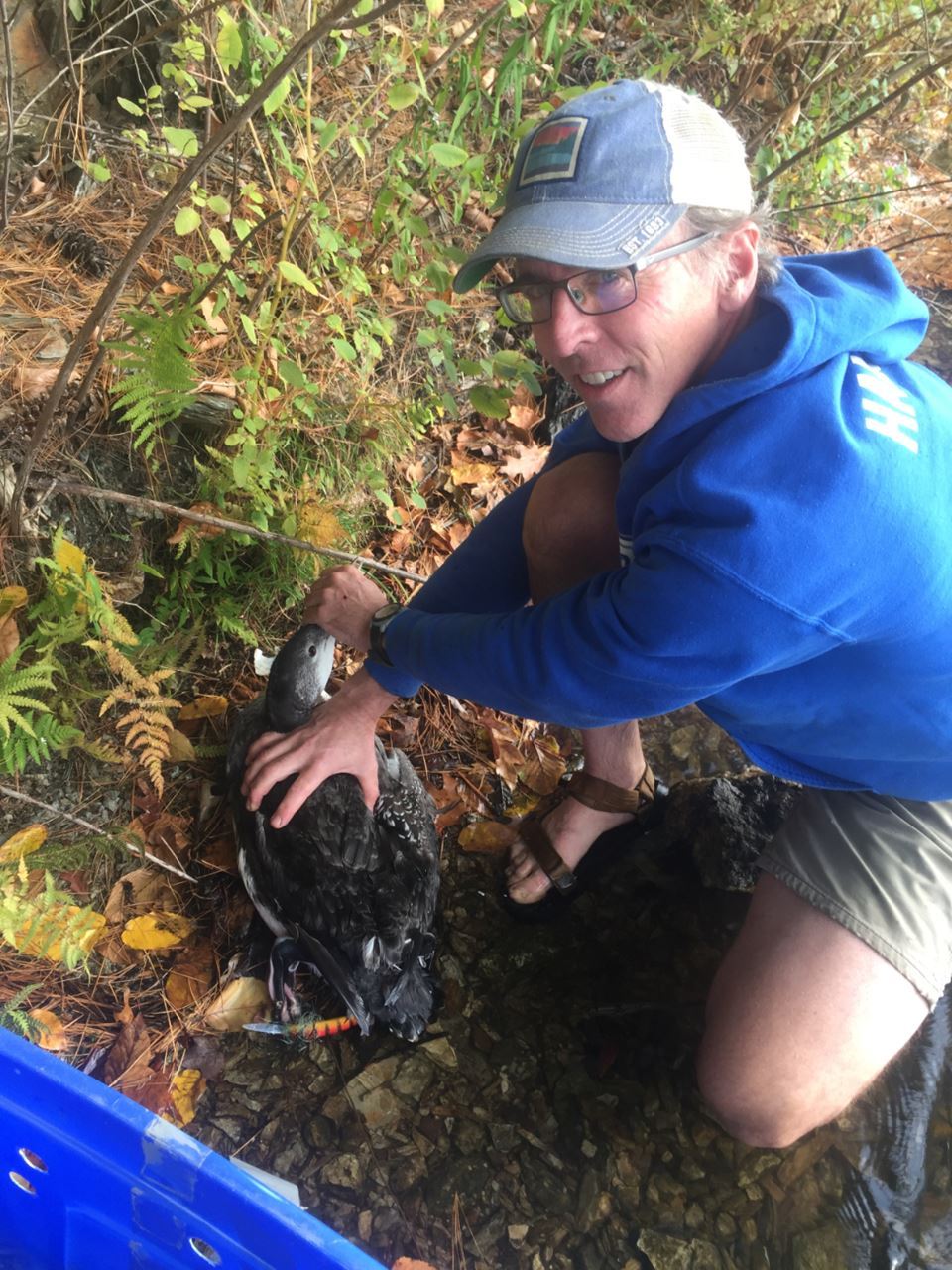Hello LSC.
We'd like to tell you about a loon rescue that took place on Wednesday on Lake St. Catherine.
Last weekend, a loon that appeared in distress was seen in North Bay. It was initially thought that the loons legs were tangled with weeds, and Loon Biologist Eric Hanson from the Vermont Center for Ecostudies was contacted.
On Monday afternoon, the loon was seen again, and fishing line and a fishing lure (4" or so) could be seen wrapped around its legs impairing its ability to do normal activities. Eric was contacted again with an update, and our Vermont Fish & Wildlife Game Warden Justin Turner was called.
On Tuesday, Justin and his partner attempted to capture the loon, but were unsuccessful. Although its legs were tangled, it was still able to elude their attempts to safely capture it.
On Wednesday, Eric came down from Craftsbury, VT to attempt to capture the loon. When he arrived, the loon was was located near shore and appeared exhausted. Thankfully, Eric was able to safely capture it:

You can see how the line had tangled around its legs:

Eric was then able to transport the loon to the Vermont Institute of Natural Science Center (VINS) in Quechee, VT. We had called ahead to make sure someone would be there to receive the loon.
Later that evening, Eric sent us an update. He explained that he met the lead rehab person at VINS and they were able to remove the line and all of the hooks that had hooked into its feet. Unfortunately, it was determined that the loon has a broken toe, and infection is a concern. Eric noted that if the loon was able to elude the Wardens while impaired, it may be strong enough to survive at 90% at the ocean this winter.
We will keep you up-to-date as we learn more about its progress at VINS. Keep your fingers crossed!
We'd like to thank the Lake St. Catherine residents who noticed and reported the loon in distress, our Game Warden Justin Turner and his partner, Eric Hanson from VCE and the folks at VINS for their efforts to give this loon a chance.
Great work by everyone involved.
If you'd like to support the efforts of VCE and VINS, you can make a donation to them on their websites.
- Donate to the Vermont Center for Ecostudies (VCE): https://vtecostudies.org/give/
- Donate to the Vermont Institute of Natural Science Center (VINS): https://vinsweb.org/donate/
We are so happy that the loon population has been increasing over the years, and as we've heard from discussions and online postings from you, we all love seeing and hearing them on the lake.
So, here are some tips to keep the loons safe and healthy from VCS and their publication, Vermont's Common Loon: A Guide For Boaters:
Respect: Enjoy loons from a distance through binoculars. When paddling, never pursue loons for a photo or closer look. A loon constantly swimming away from you is a stressed loon.
Avoid Nesting Areas: Not all nest sites are signed. Be aware of potential nests in marshes and on islands; be ready to paddle slowly away from a loon sitting on shore. If a loon leaves its nest, depart the area immediately; the loon will return once it feels safe.
Slow Down: Loon chicks can be difficult to see. If boating at high speeds, note where the loon family is and avoid that area. Please observe the “no wake speed” law within 200 feet of shorelines. Wakes from boats can flood shoreline nests and dislodge eggs, while speeding boats have been known to run over loons, injuring or killing them.
Get the Lead Out: Fish responsibly. Loons, like many birds, ingest small pebbles in order to help digest their food. Unfortunately, if the material they collect contains lead from sinkers or jigs, poisoning and death may result.
Reel In When Loons are Diving Nearby: Loons will take live bait and lures. Nearly 50% of loon deaths are caused by ingesting lead fishing gear or injury from fishing line entanglement and hooks.
Take Action: It is against the Federal Migratory Bird Treaty Act to harass migratory birds in the U.S. Please report any loon harassment to your local game warden or state police.
Plant Native Vegetation: If you own shoreline, let your lawn grow wild to create wildlife habitat. Leave woody debris and underwater plants for aquatic insects, fish, and loons. If you need a mowed area, keep it 15-20 feet from shore.
Enjoy: Vermont’s lakes and ponds can be home to both people and loons, if we treat loons with respect and are good stewards of forested shorelines and underwater habitat.
Thanks again for everyone involved in this effort. We are hopeful that the loon will be able to recover and make its way to the ocean for the winter, and we'll see it again at ice out in 2022.